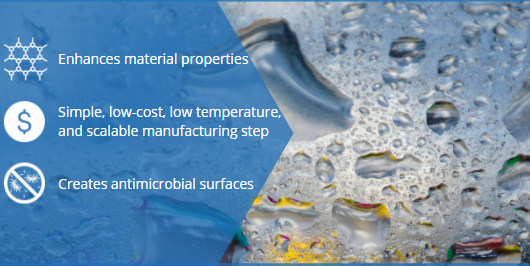Photocatalytic Nanoceramic Coatings
A novel, controlled, low-temperature process based on in-situ precipitated nanostructures grown in aqueous solution for making and non-destructively depositing functional metal oxide films on various substrates
Modifying material surfaces to enhance its properties is a common practice for a myriad of applications.
Here we present a novel process of coating substrates with an ultrathin, uniform nano-ceramic layer, This process can be done at low temperatures (90°C) and can be applied to biological and organic substrates, included but not limited to: steel, silk, polyerster, nylon, latex, PTFE, PET, PVC, PS, silicone, carbon, cellulose, wood, paper, cardboard. The coating, when moistened and exposed to natural or artificial light, advantageously generates free radicals. This reaction can be further enhanced by UV light to create a biocidal surface that can deodorize, or assist in degradation of surface deposits on the substrate after use.

- Improves materials' performance, resistance, and enables some heat- sensitive materials to be used at higher temperatures
- Simple, low-cost, low temperature, and scalable manufacturing step
- Unlike many processes that require high temperatures that can degrade materials, this process can be done at low temperatures (90°C)
- Photocatalytic property of the coating can release free radicals that can degrade odors, food residue, and bacteria, reducing the amount of detergents for cleaning
- Antibacterial activity of the coatings has also been observed in the absence of light
U.S. 10,828,400
Patent rights available for licensing.
Patent Information:
| App Type |
Country |
Serial No. |
Patent No. |
Patent Status |
File Date |
Issued Date |
Expire Date |
|